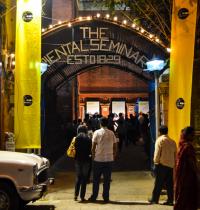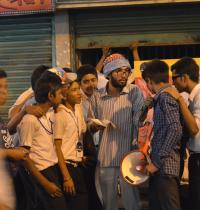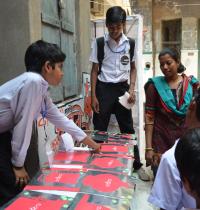Sumona Chakravarty
Grant Period: Over four months
The project “Chitpur Local” is conceived and headed by Sumona Chakravarty, an artist, designer and project manager. Sumona was trained in Art and Design from Srishti School of Art, Design and Technology, Bangalore. She is an ATSA (2014) fellow and a Masters in Art and Design for Civic Engagement from the Harvard University Graduate School of Design, USA. Her work seeks to explore the role of participatory art and design practices in creating spaces for civic engagement and reactivating the public domain. Manas Acharya, Nilanjan Das and Varshita Khaitan are playing key roles in the project as artist fellows. Manas is an interdisciplinary visual artist and curator trained at the Indian College of Art, Kolkata and Kala Bhavan, Shantiniketan. Nilanjan is a printmaker with an MFA from Rabindra Bharati University, Kolkata. Varshita is an alumnus of Srishti School of Art, Design and Technology, Bangalore and now works as a freelance graphic designer in Kolkata. They will be joined by local businessmen, old residents, other artists, and the teachers and students of the Oriental Seminary School which is located in Chitpur. Eminent culture and heritage practitioners like Naveen Kishore, Partha Ranjan Das, Paula Sengupta and GM Kapur are acting as mentors to the project.
Chitpur is one of the oldest localities in Kolkata that existed as a place of business even before the British started building the modern day city. During the British rule, Chitpur Road, the arterial road in the native part of the colonial city, prospered further as a business district. As its importance grew, Chitpur became a densely populated area and a place of historical importance housing many cultural bodies, local businesses and art forms. Today the importance of Chitpur has dwindled as the nature of business and the city has significantly changed. The Chitpur of today consists of shabby roads with dense traffic and poor localities. Although some of the traditional business and art forms still survive in the area, the historical importance of the place is rapidly being forgotten. The project ‘Chitpur Local’ aims to refresh the memory of that history and heritage among the locals as well as the citizens of Kolkata.
The group of artists led by Sumona and helped by the local residents and students have created various models towards creating interest, curiosity and awareness of the past glory of this neighbourhood in the last year. In the second phase in 2015 they are organising a series of workshops primarily to enable the local residents and students to take ownership of the project and drive it forward. They are planning various collective cultural acts dispersed over three sites in Chitpur, chosen in consultation with the local residents.
The first site, the local art school Shilpi Shrishti is the site chosen for a pop-up museum. It is housed in the residence of the De family, fifth generation residents in the area. Students of Shilpi Shrishti and Oriental Seminary, the local school with a heritage status, will take part in various workshops and co-curate the museum at the courtyard and rowak of the De residence. Local bamboo and metal craftsmen will be involved in the project to create stencils and objects that are reminders of Chitpur’s forgotten quotidian history.
The 139 year old publishing house and bookshop, Diamond Library, is the second site that will become a space for collective reading and listening. Diamond Library is one of the last surviving repositories of Jatra (local theatre) scripts. The Sheel brothers, the owners of the publishing house and the students of the Oriental Seminary will be involved in the project. Jatra scripts will be co-curated for visual, textual and performative experiences and turned into mobile ‘Story Boxes’. The students will later take them to various cultural locations across the area. Finally, these will be set up as a permanent exhibition at the Diamond Library space.
The Garanhata rowak at the end of the Garanhata Street in the neighbourhood lined with old jewellery workshops is the third site. Rowaks have always been a great place for adda, or gossip sessions, in the social fabric of Kolkata, holding a great place of community gathering, cultural, social, political, economic and intellectual exchange. It has also served as a place for board games. Chitpur Local, in its attempt to create games about this area, will use the Garanhata rowak as its starting point. Local craftsmen from jewellery, woodblock printing and lithography industries will help the students of Oriental Seminary to make cards, logos and symbols for various heritage locations in the area. They will collect stories and design signage for each and the participants in the game can collect their prizes from these locations during the final stage of the workshops. It is aimed to catalyse interaction, engagement and exploration of the history of Chitpur. At the end of the project the game will be repackaged as memorabilia of Chitpur, converting the artistic idea into an economic model that could be sold. The culmination of the series of workshops will be in the form of a two day public exhibition.
This project is being supported under the Arts Practice programme because it pushes the norms of what is usually understood as ‘community project’ in our context. It puts the ‘public’ back into public art. It is not a project where the artists, alien to the community, come in only to use the local residents as ‘native informants’ resulting in the discontinuation of the project as soon as the artists leave. This project aims to give the ownership of the project back to the community where they will be able to sustain it. The local school has already agreed to create and house a proper archive of the community. The local business and cultural institutions are as involved in the project as the artists. From the experience and learning of the first year the artists have also been able to change their approach to the project enabling more community participation and voice. The outcome of the project will be in the form of a series of workshops that will be continuously documented. These documents will be disseminated through discussion sessions and a DVD compiling everything related to the project. It will also be available on their website and Facebook page. The two day festival and subsequent workshops will mark the end of this phase. However, they aim to develop this through various routes for an even more long term engagement. Given the scope of the project the budget is very well planned, detailed and justified.




